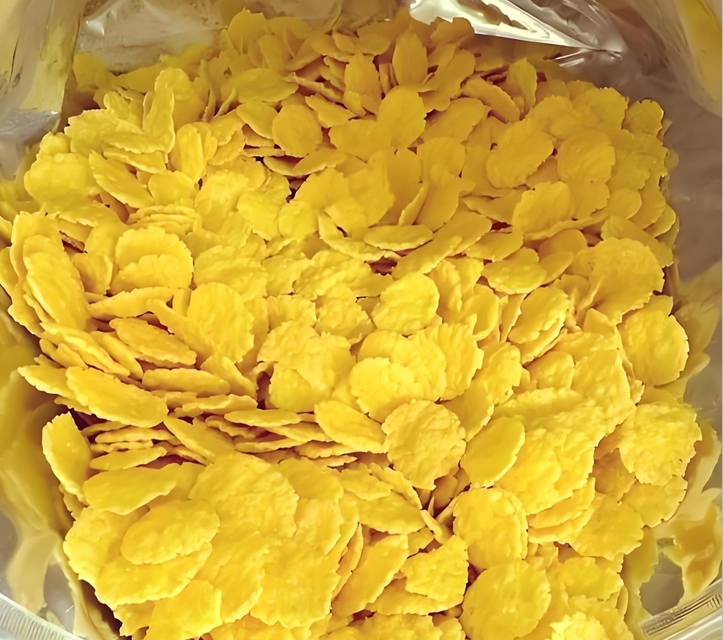Dal chicco al croccante: Il viaggio industriale di un Corn Flakes
The satisfying, robust crunch of a corn chip is a familiar sound in snack bowls around the world. But transforming a humble field corn kernel into a perfectly salted, consistently shaped chip is a feat of agricultural and food science. The process, while seemingly simple, involves a crucial ancient step that makes it all possible. Let’s dive into the factory production line to see how it’s done.
Step 1: The Essential First Step: Nixtamalization
This is the most critical and fascinating step that defines an authentic corn chip. It’s a process borrowed from ancient Mesoamerican cultures.
- What it is: Whole dried corn kernels are washed and then cooked in a large industrial kettle in a solution of water and alkali—typically food-grade lime (calcium hydroxide). This is not the fruit; it’s a mineral compound.
- Why it’s done: This alkaline cooking solution works a kind of magic. It:
- Loosens the Hull: It softens and dissolves the tough, indigestible outer hull (pericarp) of the kernel.
- Unlocks Nutrition: It makes the niacin (Vitamin B3) in the corn bioavailable, preventing deficiency diseases like pellagra.
- Develops Flavor: It creates that distinctive, slightly tangy, and earthy “masa” flavor that is the soul of a good corn chip. Without this, they would taste like plain, ground popcorn.
- Texturizes: It gelatinizes the starches, making the corn malleable enough to be formed into dough.
After cooking, the corn, now called nixtamal, is steeped in the hot solution for several hours. It is then pumped into a washer where rotating drums and high-pressure water sprays rub away the loosened hulls. What remains are soft, puffy kernels ready for grinding.
Step 2: Grinding into Masa
The cleaned nixtamal is ground in a mill. Traditionally, this was done with stone grinders, but modern factories use stainless steel mills. The grinding process creates a soft, pliable, damp dough called masa. The texture is carefully controlled; if it’s too fine, the chips will be dense and hard, if too coarse, they will be brittle and fragile.
Step 3: Sheeting and Cutting
The fresh masa is fed into a machine called a formulator. Here, it’s compressed and pushed through a series of rollers that flatten it into a wide, continuous, and perfectly even sheet. The thickness of this sheet is precisely calibrated to determine the final chip’s crunch—thinner for a light crisp, thicker for a hearty snap.
This sheet of masa then travels under a rotary cutter, which stamps out the classic triangular (or round) shapes. A device called a guitar cutter, with taut wires, can also be used to slice the sheet into strips. The excess masa scraps are recycled back into the formulator to be re-sheeted, ensuring zero waste.
Step 4: The Fryer
The raw, cut chips are conveyed directly into a long, continuous fryer filled with hot oil (typically corn, sunflower, or soybean oil) at temperatures around 350-375°F (175-190°C).
- Cucinare: The chips are fried for about 60 seconds. In this short, intense blast of heat, the moisture inside the chip flash-fries into steam, causing the chip to puff up slightly and setting its structure.
- The “Blister”: The hot oil cooks the surface, creating the characteristic tiny blisters and the golden-yellow color. The chips are not meant to be fully cooked here; they finish cooking and drying through residual heat after they exit the fryer.
Step 5: Salting and Seasoning
As the hot, oily chips exit the fryer on a conveyor belt, they enter a rotating, seasoned drum or pass under a seasoning waterfall.
- Salting: For basic chips, a precise amount of fine salt is evenly dusted over them. The residual oil helps the salt adhere.
- Aromi: For flavored chips (Nacho Cheese, Cool Ranch, etc.), a seasoning powder—a complex blend of cheese powders, spices, yeast extract, and acids—is applied in the same tumble drum. The oil is crucial for making this powder stick to the chip.
Step 6: Cooling and Inspection
The seasoned chips are conveyed through a long, multi-tiered cooling tunnel. This allows them to cool evenly and become completely crisp. Optical scanners along the line identify and use puffs of air to remove any chips that are burnt, broken, or off-color, ensuring only perfect chips move forward.
Step 7: Packaging
The cooled chips are funneled into a weighing machine, which distributes the correct amount into bags. The bags are filled with an inert gas (like nitrogen) just before sealing. This nitrogen flushing does two things: it cushions the fragile chips from breaking during transport, and, more importantly, it removes oxygen, which prevents the oil in the chips from going rancid and dramatically extends their shelf life.
Conclusione
The journey from a hard, inedible kernel to a flavorful, crunchy chip is a brilliant combination of ancient tradition and modern automation. The next time you enjoy a handful of corn chips, you’re not just eating a snack; you’re tasting the result of a chemical process discovered thousands of years ago, perfected for scale and consistency by modern engineering. That’s the real secret behind the crunch.








